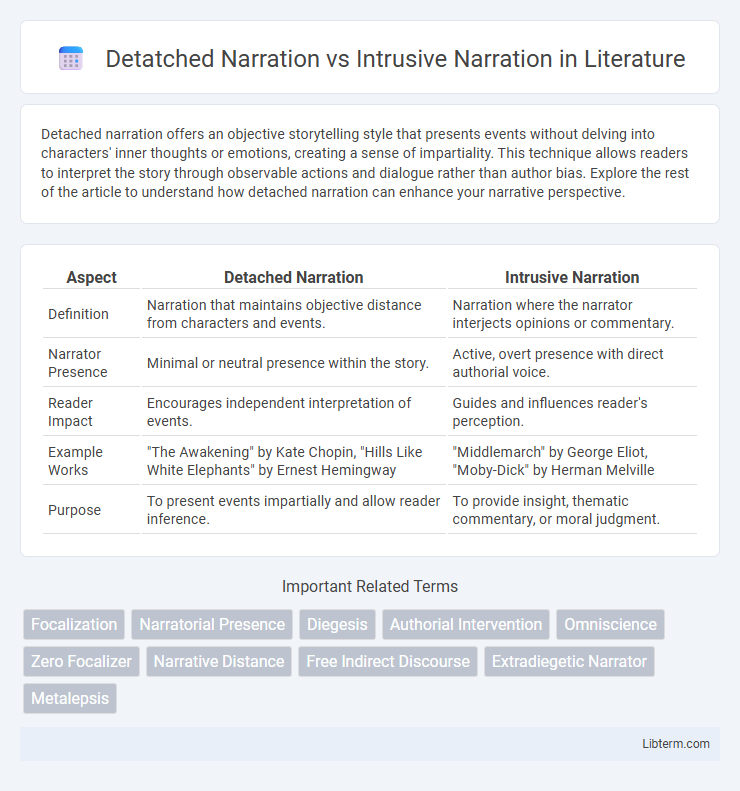Detached narration offers an objective storytelling style that presents events without delving into characters' inner thoughts or emotions, creating a sense of impartiality. This technique allows readers to interpret the story through observable actions and dialogue rather than author bias. Explore the rest of the article to understand how detached narration can enhance your narrative perspective.
Table of Comparison
| Aspect | Detached Narration | Intrusive Narration |
|---|---|---|
| Definition | Narration that maintains objective distance from characters and events. | Narration where the narrator interjects opinions or commentary. |
| Narrator Presence | Minimal or neutral presence within the story. | Active, overt presence with direct authorial voice. |
| Reader Impact | Encourages independent interpretation of events. | Guides and influences reader's perception. |
| Example Works | "The Awakening" by Kate Chopin, "Hills Like White Elephants" by Ernest Hemingway | "Middlemarch" by George Eliot, "Moby-Dick" by Herman Melville |
| Purpose | To present events impartially and allow reader inference. | To provide insight, thematic commentary, or moral judgment. |
Understanding Detached Narration
Detached narration presents the story with neutrality and objectivity, allowing readers to interpret events without the narrator's personal commentary or emotional involvement. This narrative style emphasizes observable actions and dialogues, maintaining a clear boundary between the narrator's voice and the characters' experiences. Understanding detached narration enhances comprehension of character motivations and plot developments by providing a balanced, unbiased perspective.
Exploring Intrusive Narration
Intrusive narration breaks the fourth wall by directly addressing the reader, revealing the narrator's presence and opinions within the story. This technique creates a distinct narrative voice that can influence readers' interpretation and add layers of meaning or humor. Unlike detached narration, which maintains objectivity and distance, intrusive narration engages readers by blending storytelling with commentary or reflection.
Key Characteristics of Detached Narration
Detached narration maintains an objective and impartial tone, presenting events and characters without the narrator's personal judgments or emotional involvement. This style emphasizes external actions and observable details, allowing readers to interpret characters' motivations independently. The narrator often remains invisible, ensuring the story unfolds through a neutral and unbiased perspective.
Hallmarks of Intrusive Narration
Intrusive narration is characterized by the narrator's direct interjections, offering personal opinions, commentary, or philosophical reflections that break the narrative flow. This narration style often addresses the reader explicitly, guiding interpretations and shaping the story's moral or thematic framework. Unlike detached narration, intrusive narration emphasizes the narrator's presence as an active voice within the text, influencing the reader's engagement and perception.
Emotional Impact: Detached vs. Intrusive Narration
Detached narration maintains an emotional distance, presenting events and characters without direct commentary, which allows readers to interpret emotions independently, fostering subtlety and ambiguity. Intrusive narration directly addresses the reader, offering the narrator's emotional opinions and judgments, intensifying emotional impact by guiding the reader's feelings. The choice between detached and intrusive narration shapes the reader's connection to the story, either through restrained observation or engaged empathy.
Reader Engagement: Which Style Connects?
Detached narration maintains emotional distance, allowing readers to analyze events objectively, which can enhance engagement through curiosity and interpretation. Intrusive narration directly addresses the reader, offering opinions and guiding emotions, creating a more intimate and immediate connection. Reader engagement often depends on the desired narrative effect, with detached narration appealing to analytical readers and intrusive narration fostering a personal bond through its conversational tone.
Narrative Voice and Authorial Presence
Detached narration employs a neutral narrative voice that minimizes authorial presence, allowing readers to interpret events without overt commentary or judgment from the narrator. Intrusive narration features a distinct narrative voice that directly addresses the reader, often revealing the author's opinions or insights and actively shaping the interpretation of the story. The contrast between these narrative techniques influences the degree of narrative control and the layering of meaning within the text.
Famous Works Using Detached Narration
Detached narration presents a neutral, objective viewpoint, allowing readers to interpret characters and events without authorial bias, as exemplified in Ernest Hemingway's "The Old Man and the Sea," where the sparse narrative style emphasizes the protagonist's struggle without emotional commentary. Virginia Woolf's "To the Lighthouse" also employs detached narration, using an impartial narrative voice that focuses on characters' inner thoughts through a stream-of-consciousness technique while maintaining an observational distance. This contrasts with intrusive narration, where the narrator frequently breaks the fourth wall to offer subjective opinions or direct commentary on the story.
Classic Examples of Intrusive Narration
Intrusive narration, characterized by the narrator's direct commentary and personal opinions, is prominently exemplified in classic works such as Henry Fielding's *Tom Jones* and Jane Austen's *Northanger Abbey*, where the narrator frequently addresses the reader to guide interpretation or inject humor. This narrative style contrasts with detached narration, which maintains an objective, observer-like stance without overt authorial intrusion, as observed in Ernest Hemingway's minimalist prose. The explicit presence of the narrator in intrusive narration shapes reader engagement by blending narrative voice with critical perspective, enriching thematic depth.
Choosing the Right Narration Style for Your Story
Selecting the right narration style hinges on your story's emotional tone and reader engagement goals. Detached narration provides an objective viewpoint, ideal for conveying complex plots without bias, while intrusive narration offers direct authorial commentary, creating intimacy and guiding reader interpretation. Assessing your narrative's needs and audience expectations ensures the choice between detached and intrusive narration enhances clarity and thematic depth.
Detatched Narration Infographic

 libterm.com
libterm.com